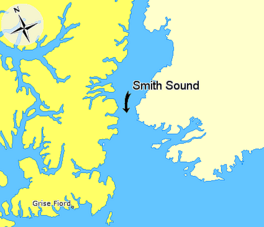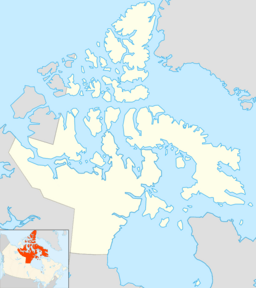Smith Sound facts for kids
Quick facts for kids Smith Sound |
|
|---|---|

Smith Sound, Nunavut, Canada. Nunavut (mostly Ellesmere Island) Greenland
|
|
| Coordinates | 78°25′N 74°00′W / 78.417°N 74.000°W |
| Ocean/sea sources | Kane Basin / Baffin Bay |
| Basin countries | Canada, Greenland |
| Max. length | 50 km (31 mi) |
| Max. width | 40 km (25 mi) |
| Frozen | Most of the year |
| Islands | Pim Island, Littleton Island |
| Settlements | Uninhabited |
Smith Sound is a large, empty sea passage in the Arctic. It lies between Greenland and Ellesmere Island, which is Canada's most northern island. This sound connects Baffin Bay with Kane Basin. It is also part of a bigger waterway called the Nares Strait.
On the Greenland side of Smith Sound, there used to be small settlements. These places, called Etah and Annoatok, are now empty.
Contents
Smith Sound: A Frozen Arctic Passage
Smith Sound is a very cold and often frozen body of water. It stretches for about 50 kilometers (31 miles) long. It is also around 40 kilometers (25 miles) wide. Most of the year, this sound is covered in ice.
Where is Smith Sound Located?
This important passage is found in the far north of our planet. It sits between two large landmasses. To the east is Greenland, a huge island that belongs to Denmark. To the west is Ellesmere Island, which is part of Canada.
Who Explored Smith Sound?
The first Europeans to visit this area arrived a long time ago.
Early Explorers in the Arctic
In 1616, a ship named the Discovery sailed into this region. Its captain was Robert Bylot, and William Baffin was the pilot. They were the first to record seeing this sound.
The sound was first named Sir Thomas Smith's Bay. This was to honor an English diplomat named Sir Thomas Smythe. By the 1750s, maps showed it as Sir Thomas Smith's Sound.
Later Expeditions
However, no one explored the area much more until 1818. That year, John Ross led an expedition there. By this time, people had started calling it simply Smith Sound.
In 1852, Edward Augustus Inglefield sailed even further north. He went past where Baffin had been. This set a new record for how far north anyone had traveled in North America.
See also
 In Spanish: Estrecho de Smith para niños
In Spanish: Estrecho de Smith para niños


